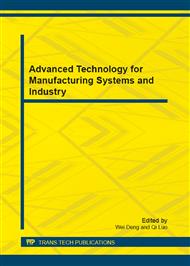[1]
Yuan Yonggen, The Method of Reconciliation and Estimation of Chemical Process Data. Computers and Applied Chemistry, 1985, 2(4): 259.
Google Scholar
[2]
Zhang Zhengjiang, An Optimization Method Based on Mnemonic Enhancement for Solving Data Reconciliation Problems [J]. Journal of Chemical Engineering of Chinese Universities, 2011, 1003-9015(2011)03- 0482-07.
Google Scholar
[3]
Kelly J D. Techniques for solving industrial nonlinear data reconciliation problems [J]. Computers Chem. Engng, 2004, 28: 2837-2843.
DOI: 10.1016/j.compchemeng.2004.06.009
Google Scholar
[4]
Song Kun,Li Lijuan, Gross error detection of soft-sensing data based on WMMMD [J]. Journal of Chemical Engineering of Chinese Universities, 2011, 1000-7024 (2011) 05-1766-04.
Google Scholar
[5]
Li Jinrong, Dai Liankui. Novel data reconciliation model and gross error detection [J]. Journal of Zhejiang University, 2003, 5(13): 16-24.
Google Scholar
[6]
Yan Xuefeng, Bao Junjie. Data reconciliation method containing nodal and measurement test and its application [J]. Journal of Chemical Industry and Engineering, 2007, 11-2828-06.
Google Scholar
[7]
Yang Youlin, Teng Rongbo. Gross error detection and data reconciliation in process indusrties [J]. Journal of Chemical Industry and Engineering, 1996, 4.
Google Scholar
[8]
Binder T, Blank L, Dahmen W., Marquardt W. Towards Multiscale Dynamic Data Reconcili- ation , In Berber R, Kravans C(Eds): Nonlinear Model Based Process Control [M]. NATO ASI Series, Kluwer Academic Publishers, 1998: 623-66.
DOI: 10.1007/978-94-011-5094-1_21
Google Scholar
[9]
Jiang Yuguang, Liu Ailun. Gross Error Detection and Data Reconciliation Based on A GLR-NT Combined Method [J]. Journal of East China University of Science and Technology, 2011, 1006-3080( 2011) 04-0502-07.
Google Scholar
[10]
Kelly J D. Reconciliation of process data using other projection matrices[J]. Computers Chem. Engng, 1999, 23: 785-789.
DOI: 10.1016/s0098-1354(99)00006-x
Google Scholar
[11]
Huang Chunpeng, Xia Maosen. Study on modified time series method of data correct in petrochemical equipment [J]. Computer Integrated Manufacturing Systems, 2004, 10 (7): 858-866.
Google Scholar
[12]
Zhang Qiran. Investigation on Multi-Resolution Modelling and Data Rectification for Process Industries. Doctoral Dissertation of Zhejiang University, (2006).
Google Scholar
[13]
Peng Juanjuan, Research on Data Reconciliation and Application, Journal of Zhejiang University, (2006).
Google Scholar


